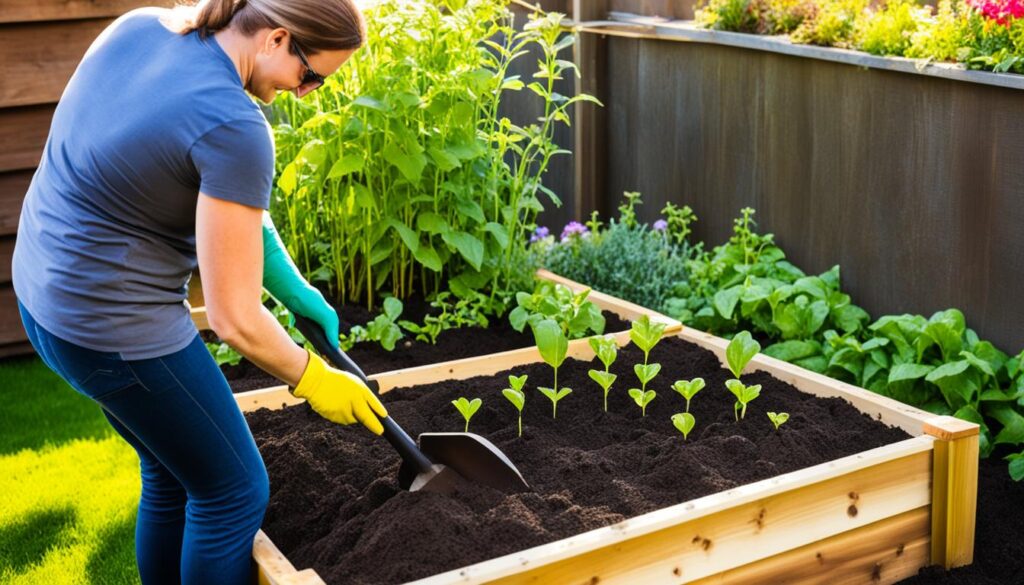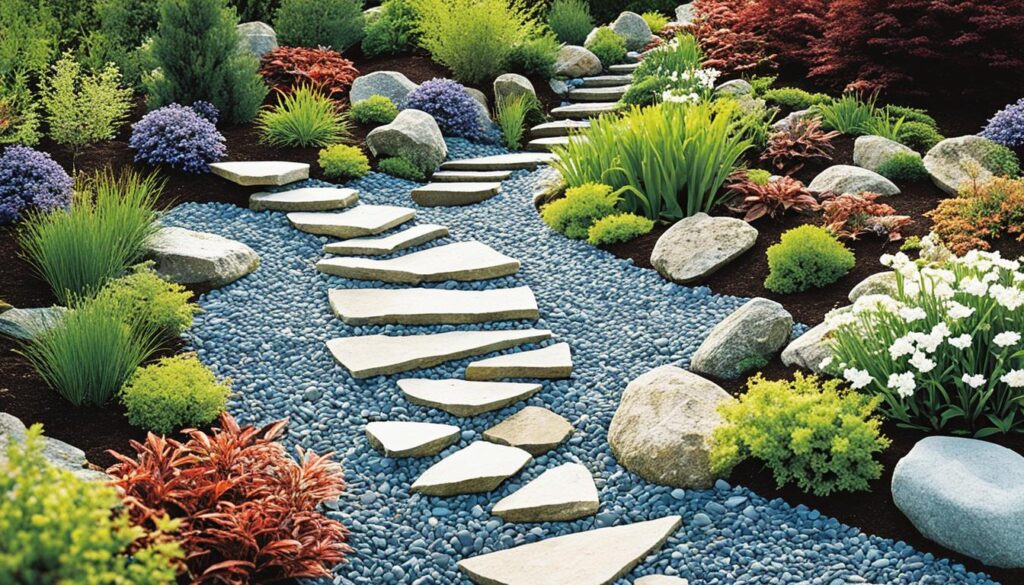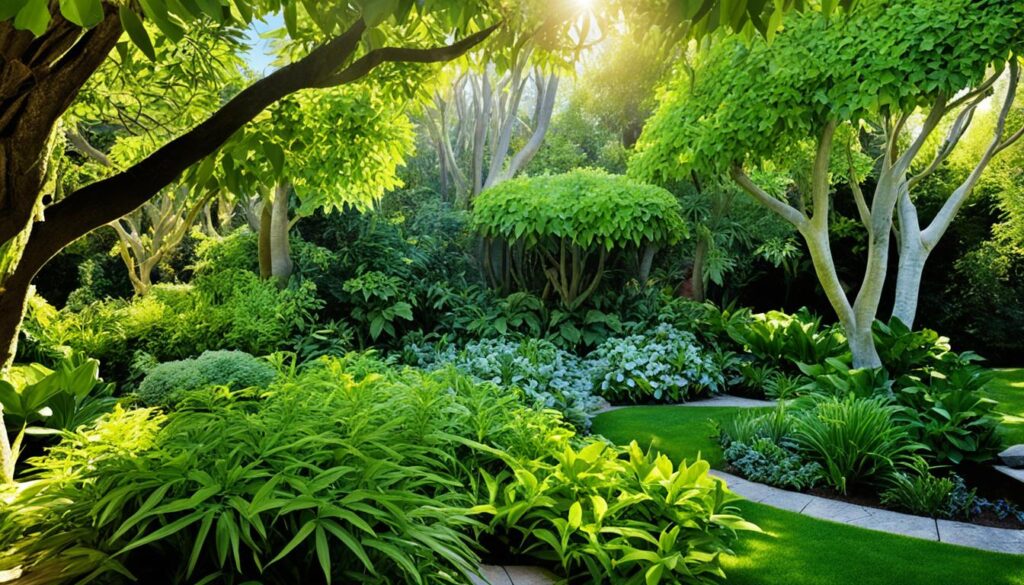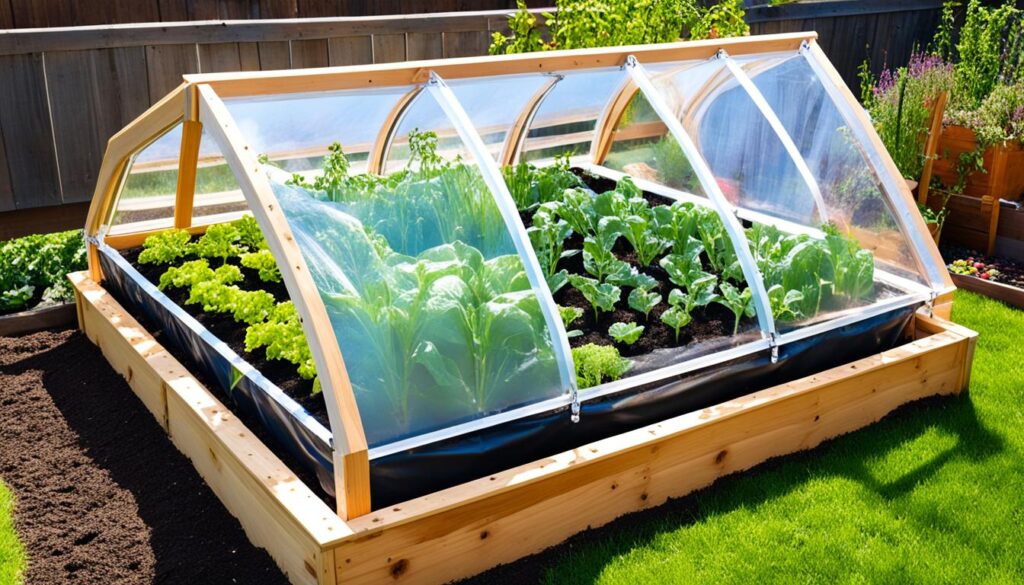In this guide, I will show you how to make your own potting soil. By creating your own homemade potting mix, you can ensure that your plants thrive with a perfect blend of organic ingredients. Follow along with this step-by-step potting soil guide to discover the joy of gardening and provide your plants with the best potting soil components.
Creating your own DIY potting soil can be a rewarding and cost-effective way to nurture your plants. Not only will it allow you to customize the blend to meet the specific needs of your garden, but it will also give you peace of mind knowing that you have control over the quality and composition of the soil.
Whether you’re an experienced gardener or just starting out, making your own potting soil is a simple process that can benefit your plants and the environment. By opting for organic potting soil, you can minimize the use of harmful chemicals and promote a more sustainable gardening practice.
Key Takeaways:
- Creating your own homemade potting mix allows you to customize it to meet the specific needs of your plants.
- Using organic potting soil promotes a healthier and more sustainable gardening practice.
- Making your own potting soil gives you control over the quality and composition of the soil.
- DIY potting soil is a cost-effective alternative to store-bought mixes.
- Follow this step-by-step guide to create the best potting soil components for your plants.
Understanding Potting Soil
Before we dive into making your own potting soil, it’s important to understand what it consists of and the nutrients it provides to your plants. By knowing the essential potting soil ingredients and understanding their role in plant growth, you can create a customized mix that meets the specific needs of your garden.
When it comes to potting soil, it’s more than just dirt. It’s a carefully formulated blend of various components that provide the necessary nutrients for plants to thrive. These potting soil ingredients combine to create a fertile environment that supports healthy root development and overall plant vitality.
One key aspect to consider is the potting soil nutrients it provides. Just like humans need a balanced diet to stay healthy, plants require a mix of essential nutrients to grow and flourish. These nutrients include macronutrients such as nitrogen, phosphorus, and potassium, as well as micronutrients like iron, manganese, and zinc.
By understanding the potting soil ingredients and the nutrients they offer, you can tailor your mix to suit different plant types and their specific requirements. For example, plants that prefer well-draining soil may benefit from the addition of perlite or vermiculite, which helps to improve drainage. On the other hand, moisture-loving plants may benefit from incorporating coconut coir or peat moss into the mix, which helps retain water.
In the next section, we will explore the numerous benefits of making your own potting soil and how it allows you to have greater control over the quality and composition of your gardening mix.
Benefits of Homemade Potting Soil
Making your own potting soil offers numerous benefits. By using a homemade potting mix, you have control over the quality and composition of the soil. This allows you to tailor the mix to the specific needs of your plants, ensuring optimal growth and health.
One of the main advantages of using a homemade potting mix is the ability to choose organic potting soil components. Organic potting soil minimizes the use of harmful chemicals, such as synthetic fertilizers and pesticides, which can be detrimental to both your plants and the environment. By opting for organic potting soil, you are promoting a healthier and more sustainable gardening practice.
Additionally, creating your own potting soil can save you money in the long run. Instead of purchasing pre-packaged mixes, you can utilize readily available ingredients and customize them based on your specific gardening needs. This not only reduces costs but also allows you to experiment with different combinations to find the perfect blend for your plants.
Furthermore, by making your own potting soil, you can ensure its freshness. Pre-made potting mixes may sit on store shelves for extended periods, which can result in nutrient depletion or the growth of harmful pathogens. With homemade potting soil, you have the advantage of using fresh ingredients and minimizing the risk of contamination.
Overall, opting for a homemade potting mix provides you with greater control, healthier plants, and cost-effective gardening. It’s a rewarding and sustainable approach that allows you to nurture your plants with a blend that suits their individual needs.

Gathering Potting Soil Ingredients
Now that you understand the importance of potting soil ingredients, let’s gather everything you need to create your own mix. I’ll provide you with a simple potting soil recipe and guide you through the selection of each ingredient, ensuring you have the perfect components for your homemade blend.
Creating your own potting soil allows you to customize the mix based on your plants’ specific needs. It’s important to choose the right potting soil ingredients to promote healthy growth and provide essential nutrients.
The Essential Potting Soil Ingredients
1. Organic compost: Start with a high-quality organic compost to provide the necessary nutrients for your plants. Look for compost made from a mix of plant materials, such as leaves, grass clippings, and vegetable scraps.
2. Peat moss: Peat moss retains water and improves aeration in the soil. It loosens compacted soil, allowing roots to penetrate easily.
3. Perlite: Perlite helps to improve drainage and prevent soil compaction. It also aids in root development by providing airspace in the mix.
4. Vermiculite: Vermiculite helps to retain moisture in the soil and improves water-holding capacity.
5. Organic matter: Adding organic matter such as well-rotted manure or composted leaves enriches the soil with essential nutrients and improves its overall structure.
6. Optional ingredients: Depending on your plants’ needs, you may want to include additional ingredients such as sand, coconut coir, or lime to adjust the pH level.
Remember, the key to a successful potting soil mix is to strike the right balance between moisture retention, aeration, and nutrient-rich organic matter.
Now that you’re familiar with the essential potting soil ingredients, let’s move on to the next step: mixing your potting soil. But before we do that, take a moment to appreciate this image illustrating the beauty of potting soil ingredients:
Isn’t it amazing how nature provides everything we need to nurture our plants? Now, let’s dive into the process of mixing your own potting soil and discover the joy of creating a perfect blend for your garden.
Mixing Your Potting Soil
Now that you have gathered all the necessary potting soil ingredients, it’s time to mix them together and create your own DIY potting soil. This step-by-step guide will walk you through the process, ensuring you achieve a well-balanced mix that promotes healthy plant growth.
Proper Ratios and Techniques
- Start by preparing a large container or bucket to hold the ingredients. This will make the mixing process easier and more efficient.
- Pour in the potting soil ingredients according to the ratios specified in your potting soil recipe. This may include components such as compost, peat moss, perlite, vermiculite, and sand.
- Use a garden trowel or your hands to thoroughly mix the ingredients together. Make sure they are evenly distributed throughout the mixture.
- Continue mixing until you achieve a uniform texture and color. This will indicate that the potting soil ingredients are well combined.
- Take a handful of the mix and squeeze it gently. It should hold its shape without crumbling, but also not feel excessively wet or compacted. Adjust the moisture content if necessary by adding more peat moss or water.
The Importance of a Well-Balanced Mix
Creating a well-balanced mix is crucial for the success of your plants. The DIY potting soil you create should provide the right combination of nutrients, moisture retention, and drainage. Be mindful of the specific needs of the plants you’ll be using the potting soil for and adjust the ratios accordingly.
By following these guidelines and paying attention to the proper ratios and techniques, you can ensure that your DIY potting soil is of high quality and will provide an ideal growing medium for your plants.
Adjusting Potting Soil pH
The pH level of your potting soil is crucial for the overall health and growth of your plants. It determines the availability of nutrients and influences the ability of plants to absorb them. Therefore, it’s essential to test and adjust the pH of your potting soil to create the optimal environment for your plants to thrive.
To test the pH of your potting soil, you can use a pH testing kit available at garden centres or nurseries. Follow the instructions provided with the kit to obtain an accurate reading. Generally, a pH between 6 and 7 is suitable for most plants.
If the pH of your potting soil is too acidic (below 6), you can increase the pH by adding organic materials such as dolomite lime or crushed eggshells. These additives help to raise the pH and reduce acidity, creating a more neutral environment for your plants.
On the other hand, if the pH is too alkaline (above 7), you can lower it by incorporating acidic amendments like elemental sulfur. Acid-loving plants, such as blueberries or azaleas, benefit from a slightly more acidic pH level.
Remember to make adjustments gradually and retest the pH after a few weeks. Avoid making drastic changes as sudden pH fluctuations can stress your plants.
In addition to adjusting the pH, it’s important to ensure that your potting soil has adequate nutrients. Nitrogen (N), phosphorus (P), and potassium (K) are the primary macronutrients needed for plant growth. Consider using fertilizers or organic compost to provide these essential nutrients to your potting soil.
By maintaining the appropriate pH level and nutrient balance in your potting soil, you’ll create an environment that supports healthy plant growth and maximizes the potential of your garden. Happy gardening!
Using Your Homemade Potting Soil
Now that your homemade potting mix is ready, it’s time to put it to use. With this customized blend, you can provide your plants with the best possible growing medium tailored to their specific needs.
When it comes to using your homemade potting mix, timing is crucial. For seed starting, fill your seed trays or pots with the potting soil and gently press it down. Make sure to moisten the soil before sowing the seeds. The well-draining nature of your homemade potting mix will promote healthy germination.

Transplanting Seedlings
Once your seedlings have reached the appropriate size, it’s time to transplant them into larger pots or directly into your garden beds. Dig a hole in the new container or garden bed, ensuring that it is large enough to accommodate the roots of the seedling. Gently remove the seedling from its previous pot and place it in the hole, making sure that the top of the root ball is level with the soil surface. Fill in the gaps around the seedling with your homemade potting mix, gently pressing it down to secure the plant.
Potting Container Plants
If you have potted plants that need repotting or new additions, your homemade potting mix is perfect for the job. Choose a suitable container that has drainage holes, fill it with your potting mix, and carefully remove the plant from its current pot. Place the plant in the new container, ensuring that the top of the root ball is level with the soil surface. Fill in the gaps around the plant with your homemade potting mix, gently pressing it down.
Bedding Plants
When it comes to planting in your garden beds, your homemade potting mix can enrich the soil and give your plants a head start. Dig a hole in the prepared area, ensuring that it is deep enough to accommodate the root system of the plant. Place the plant in the hole, making sure that the top of the root ball is level with the soil surface. Fill in the gaps around the plant with your homemade potting mix, gently pressing it down.
Remember to water your newly planted seedlings, container plants, or bedding plants thoroughly after planting to help settle the soil and provide essential moisture for their growth. Monitor the moisture levels in the soil and water accordingly, keeping in mind the specific needs of each plant.
Storing and Maintaining Potting Soil
Proper storage and maintenance are crucial to preserve the quality of your homemade potting mix. By following these tips, you can ensure that your potting soil remains fresh and ready for use whenever you need it.
1. Store in a Cool, Dry Place
Find a cool and dry location to store your homemade potting mix. Moisture can lead to mold and fungal growth, so it’s important to keep the soil dry. Avoid storing it in areas where it may be exposed to excessive heat or direct sunlight, as this can dry the soil out too much and lead to nutrient loss.
2. Use Airtight Containers
Transfer your potting soil to airtight containers to prevent moisture and pests from entering. Mason jars or plastic storage containers with tight-fitting lids work well for smaller amounts of soil, while larger bins or bags with zip locks are suitable for larger quantities. Label the containers to easily identify the contents and the date it was prepared.
3. Prevent Weed Growth
Weeds can quickly take over your potting soil if not properly controlled. To prevent weed growth, regularly inspect your stored soil and manually remove any weeds that may have sprouted. Applying a layer of fine mulch on top of the soil can also help suppress weed growth and conserve moisture.
4. Reviving Your Potting Soil
If your potting soil has been stored for an extended period, it may become compacted and lose its moisture-holding capacity. Before using it again, loosen the soil by fluffing it with a garden fork or your hands. You can also add organic matter, such as compost or coconut coir, to rejuvenate the soil and improve its overall quality.
Storing and maintaining your homemade potting mix ensures that you always have a ready supply of nutrient-rich soil for your plants. By following these simple guidelines, your potting soil will stay fresh and provide the optimal growing medium for your plants.
Troubleshooting Common Potting Soil Issues
While following the potting soil recipe and creating your DIY blend, you may encounter a few common issues. Don’t worry! I’m here to help you troubleshoot and overcome these challenges.
Poor Drainage
Poor drainage can lead to root rot and other plant problems. If your potting soil is retaining too much water, try adding perlite or vermiculite to improve drainage. These lightweight additives create air pockets in the soil, allowing excess water to escape.
Compacted Soil
Compacted soil can hinder root growth and limit nutrient absorption. If your potting soil feels dense and compacted, try incorporating some coarse sand or coco coir. These materials help loosen the soil, improving aeration and nutrient flow.
Pest Infestation
Discovering pests in your potting soil can be frustrating. To combat this issue, you can try treating your mix with neem oil or diatomaceous earth. These natural remedies can help control pests like fungus gnats and aphids.

Nutrient Deficiency
If your plants are showing signs of nutrient deficiency, such as yellowing leaves or stunted growth, it’s time to assess your potting soil’s nutrient content. Consider adding organic fertilizers like compost, bone meal, or worm castings to enrich the soil and replenish essential nutrients.
Overwatering
Overwatering can drown plant roots and lead to various problems. To prevent this, always ensure that your potting soil is dry before watering again. You can also improve drainage by creating drainage holes in your pots or using pots with proper drainage systems.
Remember, troubleshooting potting soil issues is all part of the learning process. Don’t be discouraged if you encounter problems along the way. With a little patience and experimentation, you’ll soon master the art of creating the perfect potting soil for your plants!
Expanding Your Knowledge on Potting Soil
Potting soil is a fascinating subject with ongoing research and discoveries. As an avid gardener, I understand the importance of staying informed about the latest findings on potting soil nutrients and ingredients. By delving deeper into this topic, you can enhance the success of your gardening endeavors and provide your plants with the best possible growing medium.
In order to expand your knowledge on potting soil, I have compiled a list of valuable resources and references. These sources cover a wide range of topics, including potting soil nutrients, potting soil ingredients, and their impact on plant growth. Whether you’re a beginner looking to learn the basics or an experienced gardener seeking to refine your techniques, these resources will provide you with the insights you need.
Recommended Resources:
- The Royal Horticultural Society (RHS) – The RHS offers an extensive library of articles and guides on potting soil, covering everything from the importance of pH levels to the role of individual nutrients. Their expertise and research-backed information make them a reliable source for any gardening enthusiast.
- Gardeners’ World – This popular gardening magazine provides step-by-step guides on making your own potting compost, discussing the essential ingredients and their benefits. They also share expert tips and tricks for maintaining healthy potting soil and maximizing plant growth.
- University of Minnesota Extension – The University of Minnesota Extension offers valuable insights into managing pH levels in houseplant soils. Their comprehensive resources explain how pH affects nutrient availability and provide practical advice on testing and adjusting potting soil pH.
- Gardening Know How – This online gardening resource provides a wealth of information on organic potting soils and their benefits. From understanding the advantages of organic ingredients to tips on sourcing and using them effectively, Gardening Know How covers all aspects of organic potting soil.
By exploring these recommended resources, you’ll gain a deeper understanding of potting soil and its crucial role in plant health. Remember, knowledge is the key to success in gardening, and arming yourself with the latest information will empower you to create thriving gardens and nurture your plants with the best possible care.
Conclusion
Now that you’ve learned how to make your own potting soil, you have the necessary knowledge to create a customized blend for your gardening needs. By following the step-by-step potting soil guide, you can ensure your plants receive the best possible growing medium.
Making your own potting soil offers numerous benefits. With a homemade potting mix, you have control over the quality and composition of the soil, promoting a healthier and more sustainable gardening practice. By opting for organic potting soil, you minimize the use of harmful chemicals and support the overall well-being of your plants.
Remember to gather the proper potting soil ingredients and mix them together in the right ratios. Pay attention to the pH level of your potting soil, as it greatly influences plant health. Once your customized blend is ready, use it according to the specific needs of different types of plants.








